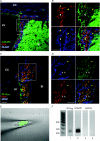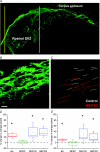Tonic activation of GLUK5 kainate receptors decreases neuroblast migration in whole-mounts of the subventricular zone
- PMID: 18565997
- PMCID: PMC2538932
- DOI: 10.1113/jphysiol.2008.155879
Tonic activation of GLUK5 kainate receptors decreases neuroblast migration in whole-mounts of the subventricular zone
Abstract
In the postnatal subventricular zone (SVZ), neuroblasts migrate in chains along the lateral ventricle towards the olfactory bulb. AMPA/kainate receptors as well as metabotropic glutamate receptors subtype 5 (mGluR5) are expressed in SVZ cells. However, the cells expressing these receptors and the function of these receptors remain unexplored. We thus examined whether SVZ neuroblasts express mGluR5 and Ca(2+)-permeable kainate receptors in mouse slices. Doublecortin (DCX)-immunopositive cells (i.e. neuroblasts) immunostained positive for mGluR5 and GLU(K5-7)-containing kainate receptors. RT-PCR from approximately 10 GFP-fluorescent cell aspirates obtained in acute slices from transgenic mice expressing green fluorescent protein (GFP) under the DCX promoter showed mGluR5 and GLU(K5) receptor mRNA in SVZ neuroblasts. Patch-clamp data suggest that approximately 60% of neuroblasts express functional GLU(K5)-containing receptors. Activation of mGluR5 and GLU(K5)-containing receptors induced Ca(2+) increases in 50% and 60% of SVZ neuroblasts, respectively, while most neuroblasts displayed GABA(A)-mediated Ca(2+) responses. To examine the effects of these receptors on the speed of neuroblast migration, we developed a whole-mount preparation of the entire lateral ventricle from postnatal day (P) 20-25 DCX-GFP mice. The GABA(A) receptor (GABA(A)R) antagonist bicuculline increased the speed of neuroblast migration by 27%, as previously reported in acute slices. While the mGluR5 antagonist MPEP did not affect the speed of neuroblast migration, the homomeric and heteromeric GLU(K5) receptor antagonists, NS3763 and UB302, respectively, increased the migration speed by 38%. These data show that although both GLU(K5) receptor and mGluR5 activations increase Ca(2+) in neuroblasts, only GLU(K5) receptors tonically reduce the speed of neuroblast migration along the lateral ventricle.
Figures




Similar articles
-
Neuroblast division during migration toward the ischemic striatum: a study of dynamic migratory and proliferative characteristics of neuroblasts from the subventricular zone.J Neurosci. 2007 Mar 21;27(12):3157-62. doi: 10.1523/JNEUROSCI.4969-06.2007. J Neurosci. 2007. PMID: 17376977 Free PMC article.
-
Adult mouse subventricular zone stem and progenitor cells are sessile and epidermal growth factor receptor negatively regulates neuroblast migration.PLoS One. 2009 Dec 2;4(12):e8122. doi: 10.1371/journal.pone.0008122. PLoS One. 2009. PMID: 19956583 Free PMC article.
-
GABA and glutamate signaling: homeostatic control of adult forebrain neurogenesis.J Mol Histol. 2007 Aug;38(4):303-11. doi: 10.1007/s10735-007-9103-8. Epub 2007 Jun 7. J Mol Histol. 2007. Corrected and republished in: J Mol Histol. 2007 Dec;38(6):602-10. doi: 10.1007/s10735-007-9153-y. PMID: 17554632 Free PMC article. Corrected and republished.
-
[Neuronal migration in the adult brain].Nihon Shinkei Seishin Yakurigaku Zasshi. 2008 Apr;28(2):63-8. Nihon Shinkei Seishin Yakurigaku Zasshi. 2008. PMID: 18516984 Review. Japanese.
-
Control of neuroblast production and migration by converging GABA and glutamate signals in the postnatal forebrain.J Physiol. 2008 Aug 15;586(16):3739-43. doi: 10.1113/jphysiol.2008.155325. Epub 2008 May 8. J Physiol. 2008. PMID: 18467361 Free PMC article. Review.
Cited by
-
The multifaceted subventricular zone astrocyte: From a metabolic and pro-neurogenic role to acting as a neural stem cell.Neuroscience. 2016 May 26;323:20-8. doi: 10.1016/j.neuroscience.2015.10.053. Epub 2015 Nov 3. Neuroscience. 2016. PMID: 26546469 Free PMC article. Review.
-
Lake-front property: a unique germinal niche by the lateral ventricles of the adult brain.Neuron. 2011 May 26;70(4):674-86. doi: 10.1016/j.neuron.2011.05.004. Neuron. 2011. PMID: 21609824 Free PMC article. Review.
-
Cell Signaling in Neuronal Stem Cells.Cells. 2018 Jul 14;7(7):75. doi: 10.3390/cells7070075. Cells. 2018. PMID: 30011912 Free PMC article. Review.
-
The role of glutamate and its receptors in the proliferation, migration, differentiation and survival of neural progenitor cells.J Neural Transm (Vienna). 2014 Aug;121(8):819-36. doi: 10.1007/s00702-014-1174-6. Epub 2014 Feb 23. J Neural Transm (Vienna). 2014. PMID: 24562403 Review.
-
PICS: a platform for planar imaging of curved surfaces of brain and other tissue.Brain Struct Funct. 2019 Jun;224(5):1947-1956. doi: 10.1007/s00429-019-01861-5. Epub 2019 Mar 22. Brain Struct Funct. 2019. PMID: 30903358 Free PMC article.
References
-
- Alt A, Weiss B, Ogden AM, Knauss JL, Oler J, Ho K, Large TH, Bleakman D. Pharmacological characterization of glutamatergic agonists and antagonists at recombinant human homomeric and heteromeric kainate receptors in vitro. Neuropharmacology. 2004;46:793–806. - PubMed
-
- Bernard A, Khrestchatisky M. Assessing the extent of RNA editing in the TMII regions of GluR5 and GluR6 kainate receptors during rat brain development. J Neurochem. 1994;62:2057–2060. - PubMed
-
- Bordey A. Adult neurogenesis: basic concepts of signaling. Cell Cycle. 2006;5:722–728. - PubMed
-
- Bordey A. Enigmatic GABAergic networks in adult neurogenic zones. Brain Res Brain Res Rev. 2007;53:124–134. - PubMed
Publication types
MeSH terms
Substances
Grants and funding
LinkOut - more resources
Full Text Sources
Molecular Biology Databases
Research Materials
Miscellaneous

